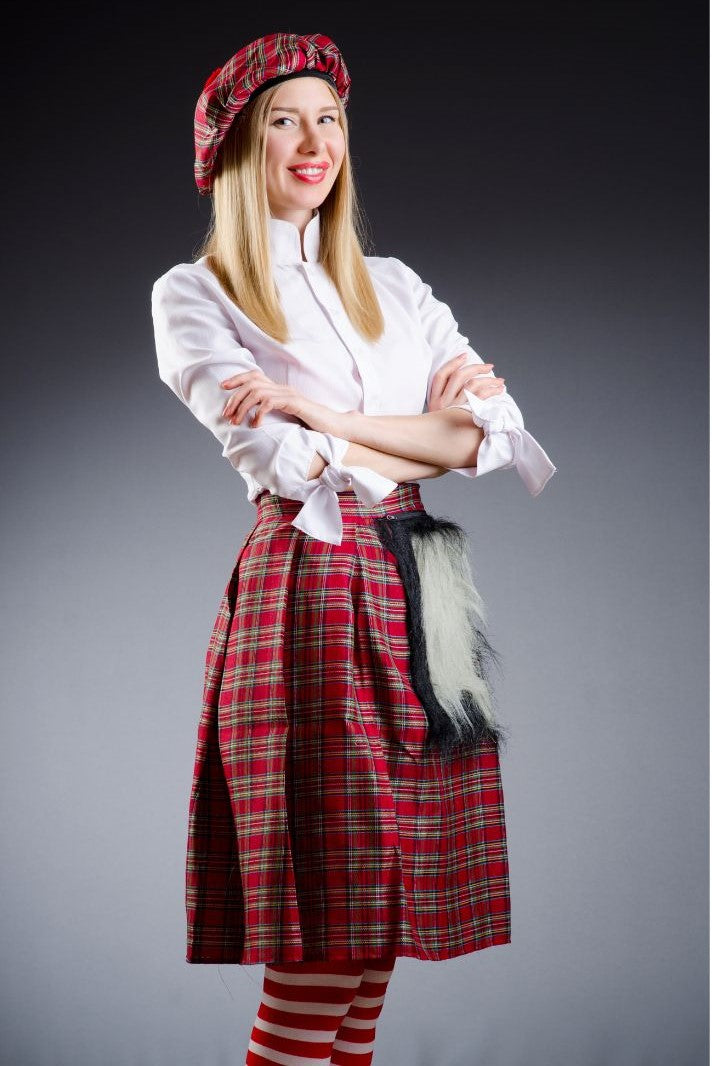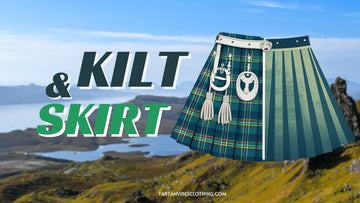Decoding Distinctions: A Comprehensive Exploration of Kilt vs Skirt in Fashion
by Marcus Harris on Jan 08, 2024
Table of Content
In the ever-evolving realm of fashion, where trends and styles weave an intricate tapestry of self-expression, the comparison between traditional and contemporary clothing opens a captivating door to exploration. Among the myriad choices that fashion offers, the intriguing dialogue of kilt vs skirt stands out, drawing attention and curiosity. This article embarks on a detailed journey to unravel the unique features that distinguish kilts and skirts, shedding light on the nuanced similarities that bind these two garments in the tapestry of personal style.
Fashion, as a mirror reflecting cultural shifts and individual narratives, often prompts questions and comparisons. Kilts and skirts, seemingly poles apart, share common ground in their ability to convey stories of tradition, versatility, and personal identity. Join us in this exploration as we delve into the historical roots, fabric choices, diverse styles, and the evolving gender perspectives surrounding kilts and skirts. Let's unravel the threads that make these garments not just pieces of clothing but statements in the ever-evolving language of fashion.
Understanding the Basics of Kilt vs Skirt
Kilts - More Than a Scottish Tradition
The journey into the distinct realms of kilts begins with their historical roots deeply embedded in the Scottish Highlands. These garments are not merely fabrics; they are living artifacts, echoing the tales of clans and heritage. Each pleat and fold holds a narrative, connecting wearers to a rich tapestry of cultural significance.
As we traverse through time, we witness the metamorphosis of kilts, from traditional tartan patterns to the contemporary expressions seen today. Kilts have gracefully embraced modernity while retaining their essence, becoming more than a mere attire – a symbol of evolution and adaptability.

Skirts - A Global Wardrobe Staple
Shifting our focus to skirts, the canvas of fashion broadens to encompass a global perspective. Skirts, unlike kilts with localized origins, have become a universal wardrobe staple. From the bustling streets of New York to the serene landscapes of Tokyo, skirts gracefully transcend cultural boundaries.
The diverse array of skirts across cultures and time periods speaks to their chameleon-like adaptability. Whether it's the vibrant hues of a flamenco skirt or the elegant simplicity of a pencil skirt, each style resonates with the cultural zeitgeist, showcasing the versatility that defines this timeless garment.
Kilt vs Skirt: A Comprehensive Comparison
Feature |
Kilt |
Skirt |
|---|---|---|
Origin |
Traditional Scottish garment |
Worn in various cultures globally |
Construction |
Pleated fabric, often in tartan pattern |
Various styles, lengths, and fabrics |
Purpose |
Often worn as part of Scottish attire |
Fashion, formal, casual, or cultural |
Fastening |
Usually secured with buckles or straps |
Elastic waistband, zipper, or buttons |
Gender Association |
Historically male, but now worn by all |
Traditionally associated with females |
Length |
Typically knee-length or longer |
Varies widely, can be short to long |
Cultural Significance |
Symbolizes Scottish heritage |
Fashion and cultural diversity |
Fabric Matters
Kilts - Embracing the Tartan
Venturing deeper into the fabric realm, we encounter the heart of kilts – the tartan patterns. These patterns are more than aesthetic choices; they are familial ties woven into the fabric. Each pattern carries a legacy, symbolizing kinship and belonging. The choice of tartan becomes a silent storyteller, narrating tales of heritage with every twist and weave.
Beyond the familial connections, the choice of fabric, particularly the emphasis on tartan, contributes significantly to the unique charm of kilts. The visual allure of the patterns, whether traditional or contemporary, adds an extra layer of distinction to kilts, making them not just clothing but a cultural emblem.
Skirts - From Cotton to Couture
Turning our attention to skirts, we find a canvas of diverse fabrics that define style and functionality. From the crisp simplicity of cotton to the luxurious textures of silk, each fabric choice shapes the overall aesthetic of a skirt. The variety in fabric options ensures that skirts cater to a multitude of tastes and occasions.
Skirts, as adaptable as they are, vary not only in style but also in the fabrics selected for different occasions. The lightweight breathability of cotton suits casual daywear, while the opulence of silk transforms a skirt into an elegant evening attire. The versatility in fabric selection enhances the role of skirts as dynamic wardrobe-essentials.
As we unravel the textile intricacies, we find that the fabric choices in kilts and skirts extend far beyond mere material preferences. They carry cultural legacies, contribute to visual aesthetics, and play a pivotal role in defining the essence of these garments. The exploration continues, delving into the expressive styles that these fabrics encapsulate.

Styles That Speak
Kilts - Formal Elegance
Stepping into the realm of style, kilts unfold a spectrum that ranges from traditional elegance to contemporary chic. The distinct styles within the world of kilts invite analysis, dissecting the intricacies of pleats, sporran placement, and the interplay of tartan patterns. Traditional styles carry the weight of history, while contemporary adaptations embrace innovation, creating a fascinating blend that defines the formal elegance of kilts.
The formal elegance of kilts transcends their Scottish origins, making them a global symbol of refined attire. No longer confined to Highland gatherings, kilts now grace formal occasions worldwide, symbolizing a timeless elegance that goes beyond cultural boundaries. The wearer becomes a custodian of tradition while making a bold statement in a global fashion context.

Skirts - Casual to Chic
Shifting our focus to skirts, we enter a world of versatile styles that seamlessly transition from casual to chic. The spectrum ranges from the laid-back comfort of maxi skirts to the sophisticated allure of pencil skirts. The beauty of skirts lies in their adaptability, effortlessly catering to diverse fashion preferences and occasions.
The versatility embedded in skirt styles positions them as indispensable elements in wardrobes worldwide. From the playful twirl of an A-line skirt to the classic sophistication of a wrap skirt, each style serves as a canvas for personal expression. Skirts become more than garments; they become vehicles for individuals to convey their unique sense of style.
As we navigate through the diverse styles of kilts and skirts, we witness a convergence of tradition and modernity. The formal elegance of kilts and the casual-to-chic versatility of skirts exemplify how these garments evolve to reflect the dynamic nature of fashion and personal expression. Join us as we further explore the gender perspectives that these styles bring to the forefront.
The Gender Perspective
Kilts - A Masculine Tradition
The journey into the gender perspectives surrounding kilts begins with their traditional association with masculinity. Kilts, historically worn by men, challenge established gender norms. The act of donning a kilt becomes an empowering gesture, breaking free from societal expectations. It's a celebration of individuality and a statement against the constraints of gendered fashion.
While rooted in Scottish tradition, kilts have ventured beyond cultural boundaries, becoming symbols of empowerment globally. The acceptance of kilts as unisex garments underscores a shift in societal attitudes towards gender-fluid fashion. The kilt, once a symbol of masculine tradition, now stands as a testament to inclusivity and breaking free from rigid gender constructs.
Skirts - A Feminine Icon
Conversely, skirts have long been associated with women's fashion, embedded in societal norms and historical context. The feminine silhouette they accentuate often reinforces traditional gender roles. However, as societal norms evolve, skirts undergo a transformation, emerging as a canvas for gender-fluid fashion where individuals express themselves beyond predefined categories.
The evolving perceptions around gender fluidity have ushered in an era where skirts are no longer confined to one gender. Men confidently embrace skirts as a form of self-expression, challenging stereotypes and contributing to the ongoing narrative of breaking free from gender constraints. The skirt transforms from a feminine icon to a symbol of gender inclusivity.
The exploration of gender perspectives within the realms of kilts and skirts sheds light on the transformative power of fashion. Kilts challenge norms, offering a glimpse into a more inclusive future, while skirts evolve from feminine icons to symbols of gender-fluid fashion. Now, let's delve into the practical aspects and comfort that kilts and skirts bring to those who adorn them.

Practicality and Comfort
Kilts - Freedom of Movement
Beyond the realms of style and gender, kilts unveil a practical dimension marked by a unique freedom of movement. The design of kilts, characterized by pleats and a lack of restrictive fabric, facilitates unrestricted mobility. This practical aspect extends beyond aesthetics, making kilts a choice not just for formal occasions but also for activities that demand ease of movement.
Central to the practicality of kilts is the sporran, a functional accessory that complements the attire. Beyond its aesthetic appeal, the sporran serves a utilitarian purpose, providing a convenient pouch for essentials. Kilts, with their emphasis on comfort, become garments not just for ceremonies but for a range of activities, from dancing at ceilidhs to casual strolls.
Skirts - Elegance Meets Comfort
Shifting our focus to skirts, we explore a delicate balance between elegance and comfort. Skirts, in their diverse styles, manage to strike a chord where aesthetic appeal meets wearable comfort. This balance allows individuals to express their personal style without compromising on the ease of movement.
Innovations in skirt design are increasingly driven by a focus on comfort. From the introduction of stretch fabrics to thoughtful additions like adjustable waistbands, designers ensure that skirts cater to the practical needs of individuals. The evolution of skirt design reflects a commitment to enhancing comfort without sacrificing style.
As we navigate through the practical dimensions of kilts and skirts, it becomes evident that these garments are not confined to the realms of fashion shows and ceremonial events. Kilts and skirts, with their practical designs, accommodate the diverse activities and lifestyles of those who choose to wear them. Join us as we conclude this exploration with a recap of the diversity in personal expression and a glimpse into frequently asked questions about kilts and skirts.
Conclusion
In the tapestry of fashion, kilts and skirts weave stories of tradition, adaptability, and self-expression. Kilts, once tied to Scottish heritage, now symbolize empowerment and inclusivity. Skirts, evolving beyond femininity, embrace diverse styles and gender-fluid fashion.
In closing, kilts and skirts are more than garments; they represent a dynamic narrative. They challenge norms, celebrate culture, and offer individuals a platform for unique expression. As the fashion landscape continues to evolve, kilts and skirts stand as versatile symbols, breaking free from constraints and embracing the ever-changing essence of personal style.
Frequently Asked Questions
Can women wear kilts?
Absolutely! Kilts are not exclusive to men; women can confidently embrace kilts, adding a touch of cultural flair to their wardrobe while challenging traditional gender norms.
What accessories complement a kilt outfit?
ccessories like sporrans, sgian-dubhs, and kilt pins complement a kilt outfit, enhancing style while holding cultural significance.
Can kilts be worn casually?
Absolutely! Modern kilts come in casual styles suitable for everyday wear. Pairing a kilt with a simple t-shirt or polo shirt creates a laid-back, stylish look.
Are there specific rules for wearing skirts?
No strict rules govern skirt-wearing. Skirts offer versatility, allowing individuals to express their unique style without limitations or constraints.






